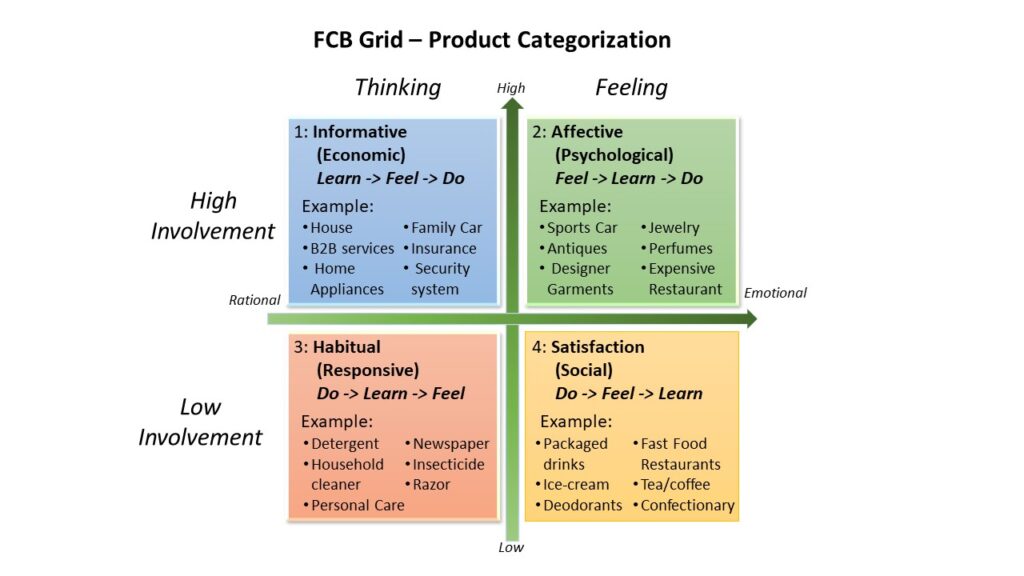FCB Model Framework and COVID impact
The FCB model framework has been used by media strategists in their marketing and advertising strategies.
COVID has changed the media landscape and also some of the traditional methods of marketing.
Let us have a look at the FCB model framework and the expected changes in marketing strategies.
The micro model of marketing communications focuses on consumers’ specific responses to communications. The buyer passes through cognitive, affective, and behavioral stages.
FCB (Foote, Cone and Belding) Model
The FCB was formulated by Richard Vaughan and his associates in 1980.
Richard Vaughn was the Senior Vice President of FCB (Foote, Cone and Belding) Advertising company at that time.
FCB model is used to assess the thinking and feeling patterns of consumers which act as the basis of strategizing advertisement
This model was designed with the help of the theory of the right or left brain.
The right brain of a human body indicates the emotional attribute, so does the feeling factor of the model.
Whereas, the left brain signifies the rational behaviour of human beings, the thinking element on the left side of the matrix does the same.
The horizontal axis represents the behaviour from rational to being emotional while the vertical axis represents the shift in consumer interest and behaviour from low involvement to high involvement.
FCB Matrix

The matrix has certain unique aspects pertaining to cognitive, affective, and behavioral stages.
Let’s have a look at what each quadrant represents, the decision-making process, and examples pertaining to each.
Quadrant 1: Informative
(Think and High Involvement)
Here, there is a relatively long customer journey before making a purchase decision.
The quality exhibited in quadrant 1 is Learn, Feel and Do.
The prospective buyer becomes aware of the product/brand and familiarizes it. There is an interest or desire phase followed by a final purchase.
High-value assets, investments, engagements, etc fall in this category where there is a lot of information gathering and evaluation.
A car for the family will involve the opinion of family members and also keeping the budget in mind. There will be a lot of information gathering and evaluation.
The best strategy to advertise in this quadrant is to provide customers with complete information and practical demonstration.
Personal selling enables to provide information and resolve queries if any.
Long info commercials, printable, long copy format, etc. help to provide detailed information to the buyer.
Quadrant 2: Affective
(Feeling and High Involvement)
Here, purchase decision-making is driven by emotions for satisfying one’s ego rather than analytical thinking.
Impact as the key driver with Feel, Learn, and Do sequence
The products are valuable, and there is a self-convincing activity during the decision-making process.
High-value emotionally satiating products and services fall in this category.
The customer journey for this quadrant is relatively shorter as information gathering is limited.
The decision to buy a sports car is a more self-driven and emotional purchase. This falls in the Affective quadrant.
Attractive images in print, TV, social media, etc. which impact consumers visually are the most suitable strategy to impress the customers.
Quadrant 3: Habitual
(Thinking and Low Involvement)
This grid signifies regular purchases that happen as a necessity to live. Ie. Monthly groceries and items that are purchased on regular basis as a habit.
Do, Lean, and Feel is the quality exhibited and reminder is the key driver
Reminder advertisement and visibility at POS, media platforms, etc are effective strategies
Quadrant 4: Satisfaction
(Feeling and Low Involvement)
Here the purchases are made by consumers with low levels of involvement and feelings.
These are impulse purchases due to personal preference, family preference, or friends and social circle.
Attention is the key driver and the quality exhibited is Do, Feel and Learn.
The best media strategy to impress customers is through Point of sale elements, billboards, newspaper ads, etc
FCB Matrix – Media Strategies

Quadrant 1 and 2 is characterized by Paid Ads focusing on Informative ads, Brand Ads, personal and direct selling, and Public relations.
Free samples, Point of sales ads, sales promotion, etc are key strategies for Quadrant 3.
Word of mouth publicity, sales promotion, billboard ads, etc. is the focus activities for Quadrant 4.
COVID Impact
The COVID has resulted in a change in the media strategies in India.
As per a report by media agency GroupM, the Ad spends in India fell by 21.5% in 2020
“Covid-19 impacted digital media the least, witnessing only a 2% contraction in spends, and is expected to grow by 28% in 2021. Print, television, outdoor, and cinema, on the other hand, declined by 43%, 14%, 73%, and 83% respectively, and are estimated to rise by 23%, 18%, 69%, and 197% this year. Further, apart from FMCG and e-commerce, categories like auto, telecom, retail, and durables will be growth drivers of India ad spend in 2021”
The share of digital Ad spend in total ad spend is expected to 35%. Ie. a 28% CAGR forecast for digital media 2021 vs 2020… GroupM Report
Also, the activities related to personal selling, direct marketing, PR activity, Word of mouth publicity, etc. have witnessed a decline.
Digital media services have been at the forefront during 2020, with companies/brands shifting their promotions to social media platforms like Facebook, YouTube, Instagram, LinkedIn, etc.
B2B meeting shifted to zoom, MS teams, etc.
As COVID impacted print media, content marketing has come to the fore.
Overall, the media strategy has witnessed a change.
The larger companies/brands have been relatively less impacted during COVID as consumers reinforced faith in trusted brands.
Summary
Looking at the impact of COVID, Quadrant 1 and 4 have taken a backseat while large value purchases reflecting the 2nd Quadrant behavior and essential purchases representing the 3rd quadrant behavior.
Digital marketing will vie for consumer eyeballs in 2021 across various social media platforms.
The move towards branded goods to sustain while lesser-known brands will require a more innovative approach to have conversions.
Connect with us for your market research requirement
